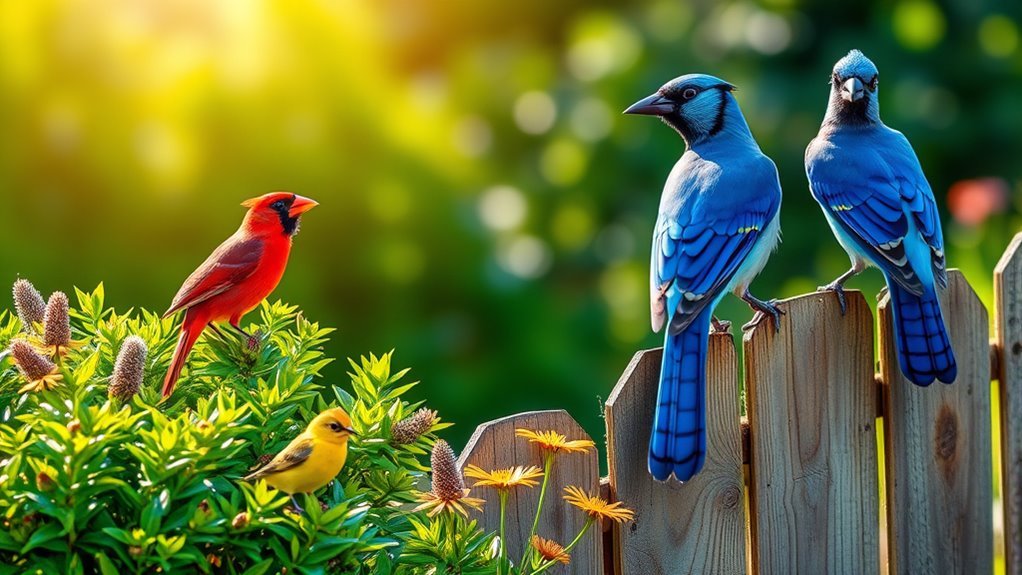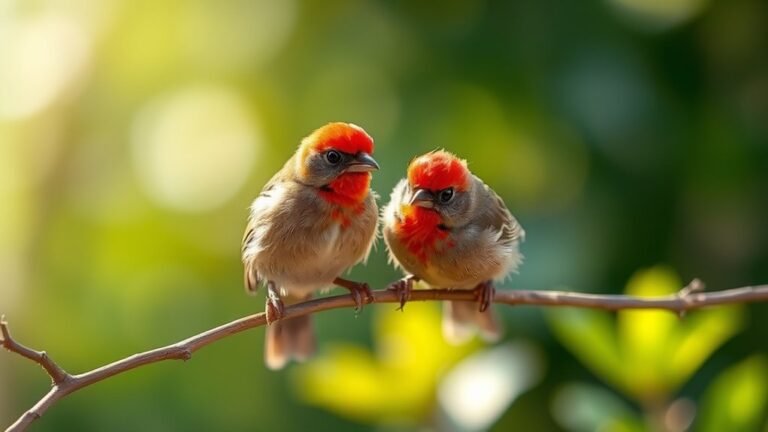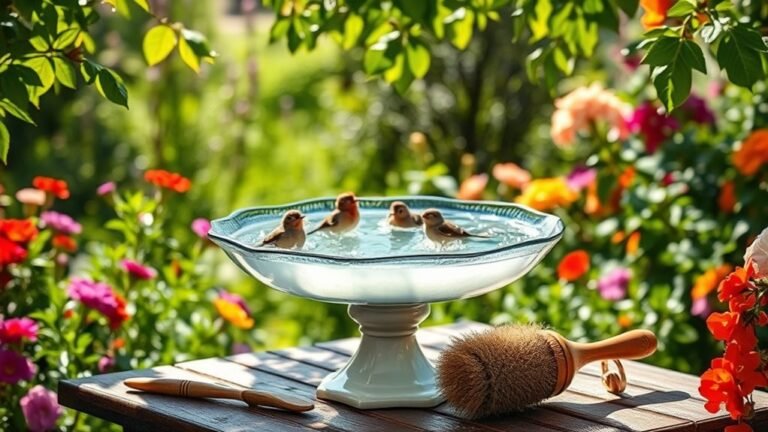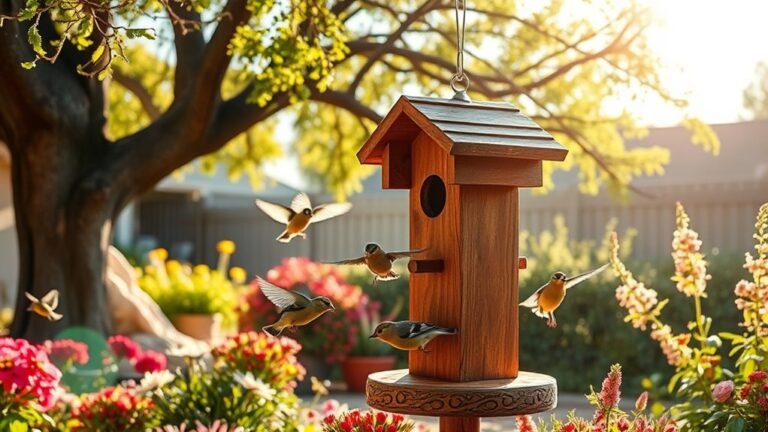North Carolina Local Backyard Birds
In North Carolina, you can see many interesting backyard birds. Each bird has its own features and behaviors. Birds like the Eastern Bluebird and Northern Cardinal brighten your garden with their colors. They also play important roles in the ecosystem. Knowing their habits can make birdwatching more enjoyable.
Several factors affect the local bird population in suburban areas. These include habitat availability, food sources, weather conditions, and human activities. Changes in these factors can influence which birds visit your backyard. By understanding these elements, you can create a bird-friendly environment and attract more species to your garden.
Key Takeaways
- Common backyard birds in North Carolina include the Eastern Bluebird, American Robin, Northern Cardinal, and Purple Finch.
- To attract birds, use feeders with sunflower or thistle seeds and maintain clean water sources.
- Native plants provide essential food and shelter for local bird species, enhancing their habitat.
- Seasonal changes impact bird diversity; spring often brings colorful songbirds, while winter attracts species like tufted titmice and goldfinches.
- Birdwatching can be enriched by using binoculars, joining clubs, and keeping a bird journal to track sightings.
Common Backyard Birds of North Carolina

As you explore North Carolina's landscapes, you'll see many common backyard birds in this area. Identifying these birds is important to appreciate their unique traits.
You might spot the Eastern Bluebird, which has bright blue feathers and prefers open fields, or the American Robin, which often searches for worms on your lawn. Each bird has specific feeding preferences. For instance, the Northern Cardinal likes seeds and fruits, while the Purple Finch feeds on conifer seeds.
Watching their behaviors and feeding habits can enhance your experience and help you connect with your backyard ecosystem. By learning about these birds, you can build a shared appreciation for North Carolina's birdlife.
Attracting Birds to Your Backyard
To attract various birds to your backyard, create a welcoming space that meets their needs.
Start with bird feeders filled with quality seeds like sunflower or thistle. These seeds appeal to many bird species. Use feeders designed to reduce waste and discourage larger birds.
Make sure you have clean water sources such as birdbaths or shallow dishes. Change the water often to keep it fresh and safe for birds.
Also, plant native plants to offer natural food and shelter. Focus on creating a balanced environment where birds can find safety and nourishment.
Birdwatching Tips for Beginners

Birdwatching can be enjoyable and rewarding. Here are some simple tips to get started.
First, buy good binoculars and a field guide. These will help you identify local birds. Start by watching birds in your backyard or nearby parks. Pay attention to their behaviors and appearances.
Consider joining a local birdwatching club. These clubs offer support and knowledge. You can learn from experienced birdwatchers.
Keep a bird journal to track your sightings. Write down details like the time, weather, and species. This will help you learn more about birds and feel connected to them.
With these tips, you'll improve your birdwatching skills and enjoy the experience more. Happy birdwatching!
Seasonal Bird Watching in North Carolina
North Carolina has a variety of birds throughout the year, making birdwatching fun and rewarding. In spring, many songbirds return to the area. This is the perfect time to look for warblers and thrushes in your backyard. Their bright colors and songs offer a delightful experience.
During winter, change your strategy. Use feeders filled with sunflower seeds or suet to attract birds that stay for the season. Look for tufted titmice and goldfinches at your feeder.
Understanding Bird Behavior and Communication

Birds use various methods to communicate and behave in their natural habitats. Understanding these behaviors helps backyard bird enthusiasts.
Here are three important aspects:
- Mating Rituals: Birds use songs and displays to attract mates. These activities show their health and genetics.
- Feeding Patterns: Birds change their foraging techniques based on food availability. They use calls to warn others of danger or to share food locations.
- Social Interaction: Some bird species form social groups. They communicate through vocalizations that indicate their social rank or unity within their flock.
Understanding these behaviors enhances your appreciation for backyard birds.
Creating a Bird-Friendly Habitat
Creating a bird-friendly habitat helps attract different bird species to your backyard.
Start by adding native plants. These plants provide food and shelter for local wildlife. Choose flowering plants that produce seeds and attract insects. This creates a diverse ecosystem.
Ensure you have water sources, like birdbaths or small ponds, for your feathered friends to drink and bathe.
Avoid chemical pesticides, as they can harm birds and reduce their food supply.
The Importance of Backyard Bird Conservation
Many people enjoy watching backyard birds, but we often forget about the need to protect them. Taking steps to conserve birds in your yard helps the environment and supports local ecosystems.
Here are some easy actions you can take:
- Plant Native Plants: These plants provide food and shelter for birds, which helps the overall biodiversity of the area.
- Limit Pesticides: By reducing the use of harmful chemicals, you support healthy insect populations, which are crucial for birds' diets.
- Add Water Sources: Include birdbaths or small ponds in your yard. These features offer birds a place to drink and bathe, promoting their health and happiness.
Frequently Asked Questions
What Time of Year Do Specific Birds Migrate in North Carolina?
Many birds migrate in specific patterns. In spring, birds return to North Carolina between March and May. During the fall, migrations usually happen from August to November. These seasonal trends allow you to predict which birds might visit your area during these times. Enjoy the sights and sounds of migrating birds each season!
How Can I Identify Bird Species by Their Calls?
To identify bird species by their calls, use simple audio recording techniques. Record calls in different locations, listen carefully, and compare them with online databases. This practice will improve your ability to recognize bird sounds and help you connect with nature more deeply. Enjoy the process of learning about the birds around you!
Are There Any Dangerous Birds in North Carolina?
Most birds are safe, but some can act aggressively when they are protecting their nests and young. Knowing how these birds behave during nesting season can help you avoid any risks and enjoy your time outdoors. Be cautious and respectful of their space, especially if you spot nests nearby. Enjoy watching birds from a distance while keeping both you and them safe.
What Are Common Feeder Preferences for Different Bird Species?
Different bird species have specific feeder preferences. Sunflower seeds attract a variety of birds, while finches prefer nyjer seeds. Understanding these preferences can help you set up a bird-friendly feeding station. By choosing the right seeds and feeders, you can attract more birds to your yard, making birdwatching enjoyable and informative.
How Does Weather Affect Bird Behavior in My Backyard?
Weather impacts bird behavior in your backyard. Cold weather drives birds to feeders. They search for food more often during cold snaps. On warm, sunny days, birds are more likely to forage outside. Knowing these patterns can improve your birdwatching experience. Enjoy observing how different weather influences the birds in your yard.

Hello, I’m Amelia White, the founder of birdsfanatic.com. As a lifelong bird enthusiast and spiritual seeker, I’ve always been fascinated by the mystical connections between birds and the human experience. On this site, I share my knowledge and insights into the symbolic meanings and spiritual significance of various bird species, exploring their roles in mythology, folklore, and cultural traditions. Join me on this journey into the world of birds, where we’ll discover the hidden wisdom and guidance that these magnificent creatures have to offer.







